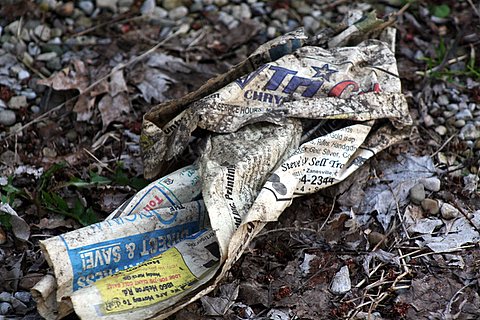
''...Innovation is the creation of new stuff that creates new categories of new stuff.'' .-Rich Gold
Wednesday, 24 November 2010
The future of e-paper: the trash can?

Wednesday, 27 October 2010
Design: e²
Friday, 10 September 2010
Biomimética aplicada al desarrollo de modelos de negocios
Gunter Pauli on Biomimetism (Lift France 09, EN) from Lift Conference on Vimeo.
En este blog la verdad creo que nunca he publicado nada acerca de negocios, mas bien esta dedicado a temas de diseño, tecnología, ciencia y una que otra disvariación acerca de como desarrollamos y trabajamos en base a procesos creativos. Pero aunque a veces no nos guste el negocio es una actividad transversal a casi todas las otras.
En el diseño el negocio...bueno casi se podría decir que el diseño es negocio. Desde el diseño como la venerable herramienta de marketing, que permite a las compañias dar una expresión formal, percibible, disfrutable y por que no deseable a los idolatrados estudios de mercado, hasta el diseño de debate plantea conceptos radicales y exploraciones filosóficas y éticas que nos llevan a cuestionarnos importantes elementos de nuestra cultura y sociedad y aunque por lo general no llegan a ser consumidos por las masas, llegan a ser apreciados por las masas en los museos los cuales pagan grandes sumas de dinero por estos objetos y así permiten a seguir generando dinero y nuevos debates con nuevos objetos, es decir continuar con el negocio.
En cuanto a la Tecnología se podría decir que desde sus inicios ha sido parte de la estructura fundamental de el negocio. Cada avance tecnológico implica primero un esfuerzo por desarrollarlo, lo que conlleva -sino una industria- un negocio en sí, pero además producto de la innovación tecnológica (desde la incremental hasta la profundamente disruptiva) se abren nuevos espacios ya sea para profundizar un negocio ya existente o para generar nuevos negocios o incluso nuevas industrias.
Cuando se trata de Ciencia el negocio permite generar y suplir la infraestructura necesaria para desarrollar el trabajo científico. Y el resultado de ese trabajo científico, el nuevo conocimiento, sustenta el negocio de su divulgación, y por cierto los negocios que se surten de ese conocimiento como el desarrollo tecnológico.
¿Pero por que tratar de encontrar el negocio en todas estas áreas cuando el objetivo de este blog nunca han sido los negocios? Y es aquí donde el vídeo posteado se justifica. De hace tiempo ya es de mi interés la idea de estudiar y aplicar los conceptos extraídos de la naturaleza en los diversos campos del conocimiento humano, la biomimética. Y en función de eso me he dejado asombrar por como la ciencia y sus nuevas técnicas nos permiten conocer los secretos microscopios de las estructuras naturales o por la tecnología cada ves se acerca mas a la eficiencia en materiales y recursos del modelo natural y por como el diseño se nutre de la inteligencia geométrica de los organismos vivos para desarrollar nuevos elementos de nuestro mundo material. Pero hasta el día de hoy jamas me había topado con la idea -bastante lógica por lo demás- de que nuestro ecosistema podría enseñarnos como estructurar una metodología para llevar a cabo algo tan propiamente humano como el negocio. Hasta hoy hemos aprendido de las estructuras de lo más pequeño y lo más grande de nuestro universo, desde las partículas elementales que componen la masa hasta los procesos siderales que dan forma al universo. Pero resulta ser que hemos pasado en alto el equilibrio base que da sustento a todos esos procesos. Podemos saber como las plantas son capaces de levantar agua hasta más de 100 metros sin la necesidad de poderosas bombas de succión pero si no sabemos por que han decidido acarrearla tan arriba y cual es la función sistémica dentro de su entorno perdemos las nociones que nos permitirían aplicar de manera coherente ese conocimiento. En una ciudad donde viven millones de personas la cantidad de desperdicio producido puede llegar a ocupar un volumen peligrosamente cercano al de la ciudad misma, en un bosque o selva donde la cantidad de habitantes -seres vivos- puede ser significativamente superior al de una ciudad los desperdicios simplemente no existen. El producto de cada proceso es alimento del siguiente.
En el sobre gerrificado lenguaje de los negocios siempre se ha de contar con ''daños colaterales'' que simplemente no entran en la ecuación. Así el fantástico negocio del biodiesel por ejemplo a costado cientos y cientos de hectáreas en el amazonas para plantar soya para hacer combustible. Pero que pasaría si en vez de buscar ser ''el mas fuerte'' en los negocios "bioficaramos" su lenguaje para hacerlo mas equilibrado, para balancear la cadena de suministros con la de desperdicios. Si en vez de pensar del todo en la etapa como desperdicio de la vida útil de los objetos habláramos de su segundo estado como suministro. En el bosque el cuerpo del animal muerto es suministro del los demás vivos y del suelo donde cae.
Esta es la impresión que me deja Gunter Paulin en esta charla, en este mundo tenemos la capacidad para convertir casi todo en objeto de negocio, quizás sea tiempo de convertir el negocio en parte de nuestro mundo.
